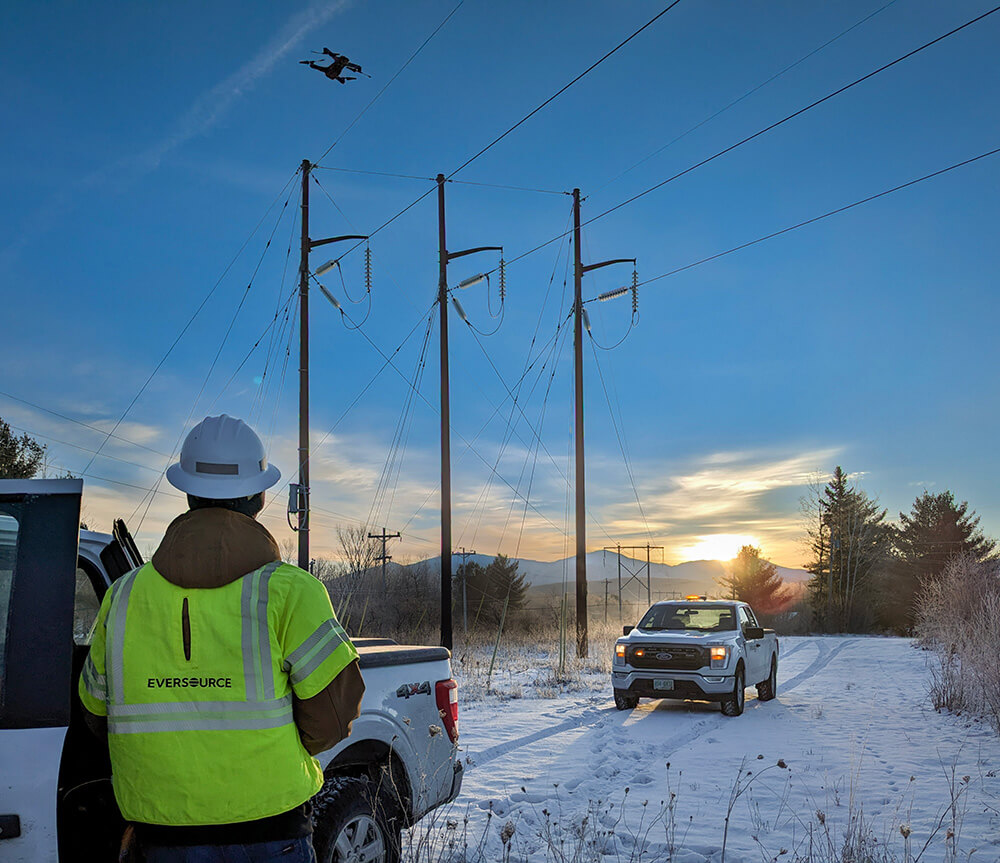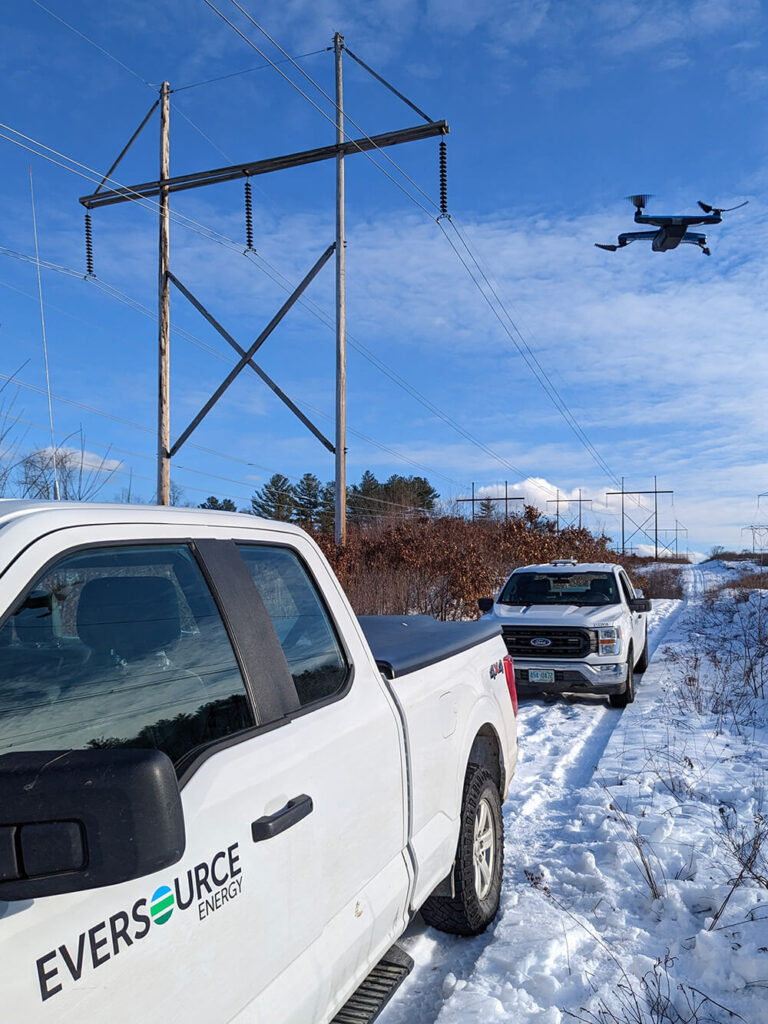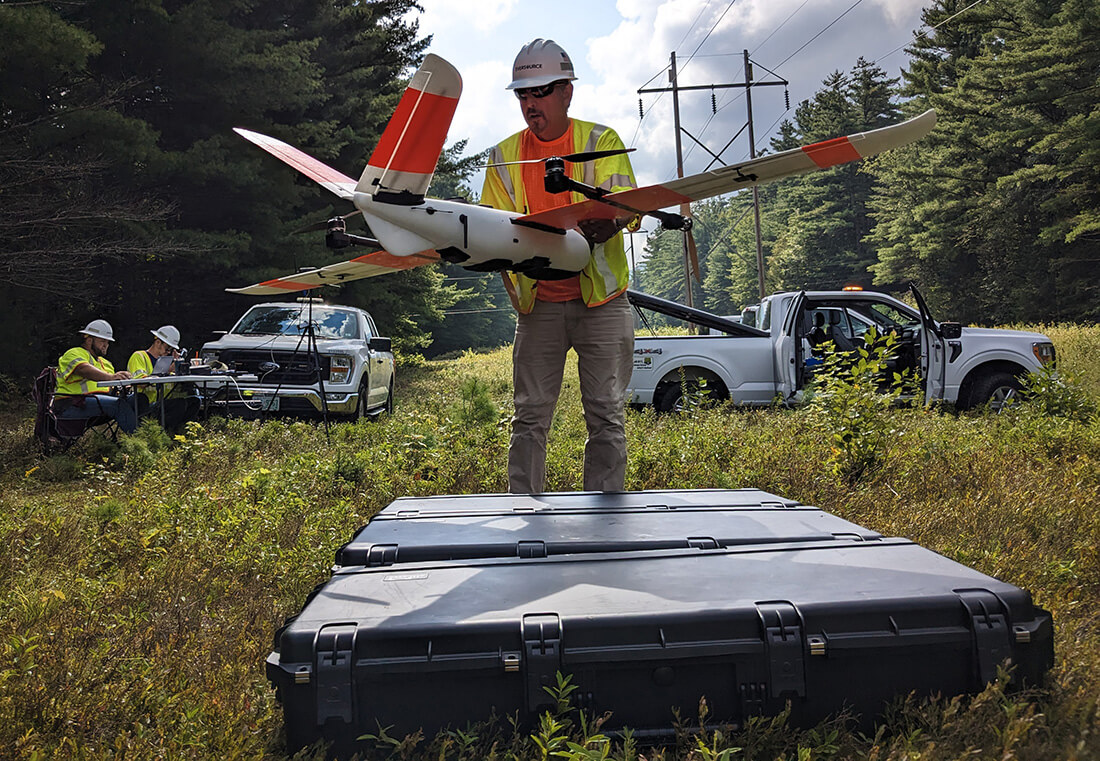Eversource Energy, a Fortune 500 energy company with over 9000 employees that provides electric, natural gas and water services to more than four million customers in the New England area, implemented a comprehensive drone program that has vastly improved their operations. In this article, Stephen Michna, the company’s Lead Engineer, Drone Engineering, describes Eversource’s path to drone integration in energy infrastructure management, from inception to current state and future plans. Read on to glean invaluable lessons learned and best practices to scale up your own enterprise program.
The Evolution of A Drone Program
Eversource’s foray into the use drone technology began in 2013 when the company first started experimenting with it. The program initially focused on transmission system inspections. Within the span of five years, Eversource had utilized drones to inspect and catalog all 35 thousand of its transmission structures, across three states.
This initial success resulted in expansions to various aspects of utility operations. By 2020, the company had fully embraced the potential of drones and established a dedicated drone engineering program. This initiative, launched by Manager of Transmission Technical Engineering Elizabeth Hall, with full senior management approval, involved creating an in-house team of 2 full-time engineers and 8 full-time FAA-certified remote pilots. Within year one, the team achieved its first beyond visual line of sight (BVLOS) flight.
Today, Eversource’s drone engineering team is a vital part of their transmission engineering department that supports multiple facets of the company’s operations.
A Team Within The Team
Eversource has been able to scale up, according to Michna, largely because they chose to centralize their drone expertise.
Michna explained, “In my opinion, it’s better to have this all centralized. This work is full time.” He continued, “Some companies tag some people to help out with their drone program part time or as an extra duty. That way is fine, but a dedicated team is better. They can assist with changing regulations, airspace automation, the ever-changing software and hardware out there and also go out into the field for our different verticals to fly difficult missions.”
To elaborate on this point, strategic centralization offers numerous benefits, chief among them being the concentration of expertise. The dedicated drone team at Eversource has developed a unique blend of UAS operational skills and utility-specific knowledge that enables them to tackle complex inspection tasks efficiently. Specialized knowledge is crucial when inspecting critical infrastructure which requires high levels of precision and safety, such as high-voltage transmission lines.
A centralized drone program provides another significant advantage in terms of regulatory compliance. The evolving labyrinth of drone regulations requires constant vigilance and adaptation. By maintaining a dedicated team, Eversource ensures that all drone operations across the company adhere to the latest Federal Aviation Administration (FAA) guidelines and local regulations. This approach minimizes legal risks.
Standardization is another key benefit of a centralized drone strategy. By implementing consistent procedures and data collection methods across all operations, the company ensures that the information gathered remains uniform and easily comparable. This standardization in maintaining a comprehensive digital record of infrastructure conditions enables more accurate trend analysis and predictive maintenance planning. (More on this below).
The centralized model also allows for efficient resource allocation. Eversource can flexibly deploy its drone equipment and personnel to areas where they are needed most to maximize the utility of these valuable assets. This agility remains particularly crucial during emergency situations, where rapid damage assessment can significantly speed up power restoration efforts.

If You Build It, They Will Come
Because Michna’s team has grown into a stable of go-to assets in the company, what started out as a tool for basic inspections has morphed into a multifaceted program with wide-ranging applications. Eversource has significantly expanded its drone program to enhance efficiency, safety and reliability across its vast service territory.
The utility’s drones now play a crucial role in annual transmission line inspections. They inspect over 90 percent of the company’s transmission system structures annually. This includes more than 4000 circuit miles that cover 2,300 miles of right of way (ROW). The team pulls in over 7 terabytes of data annually from inspections alone, which includes 600,000 photos and 2 million plus inspection data points.
The program has evolved to include advanced technologies and techniques. At the forefront of these advancements, Michna’s team has equipped its drones with Light Detection and Ranging (LiDAR) sensors. They can now create highly accurate 3D models of power lines, towers and surrounding landscapes. This precision mapping enables the utility to measure clearances between power lines and vegetation with unprecedented accuracy for proactive maintenance and outage risk reduction.
Complementing LiDAR, Eversource also expanded its use of thermal imaging technology. Advanced thermal cameras mounted on drones allow for early detection of equipment issues, such as overheating transformers or malfunctioning insulators. This predictive maintenance approach helps prevent costly failures and enhances overall system reliability.
The combination of LiDAR and thermal imaging alone has transformed Eversource’s inspection processes by enabling more comprehensive assessments in less time. Michna and his team also used other advanced methods, such as photogrammetry and multispectral imaging, to provide even more comprehensive data collection. Eversource also implemented live streaming capabilities to provide real-time situational awareness to decision-makers during operations or emergencies. All of this allows the utility to identify potential hazards, plan infrastructure projects more effectively and ensure the optimal performance of its assets.
Tackling Data Management
As Eversource’s drone program rapidly expanded, the utility giant faced the challenge of managing the unprecedented volume of data it collected during its aerial inspections. With hundreds of thousands of images captured annually from transmission line inspections alone, not to mention videos and other critical data points, Michna recognized the need for a sophisticated data management strategy to maximize the benefits of its drone operations. To tackle this data deluge, he and his team developed a multi-faceted approach that combines custom solutions with cutting-edge software platforms.
Up front, in recognition of the importance of consistency across its vast operations, Eversource implemented standardized data collection and reporting protocols. These uniform standards ensure that information gathered by different departments and external vendors can be easily integrated and analyzed to provide a comprehensive view of the utility’s infrastructure health.
On the back end, the team developed an in-house innovative automated sorting system. It leverages GPS data and structure information to categorize images efficiently. This automation significantly reduces manual processing time and improves overall data organization.
In addition to its own software, Eversource also invested in specialized off-the-shelf inspection software platforms designed to streamline data analysis and reporting. These tools allow for more efficient identification of potential issues, prioritization of maintenance tasks and generation of actionable insights from the vast amount of collected data.
The company additionally invested in cloud-based storage solutions to handle the sheer volume of data generated by drone inspections. This move not only provides ample space for their growing data needs but also enables quick and secure access to information from various locations for enhanced collaboration and decision-making.
Michna provided some lessons learned along the way. “By working backwards from our desired outcomes, we could identify and implement the most effective technologies and workflows for our unique needs,” he noted. “Taking this type of strategic approach to data management greatly enhanced the efficiency of our drone program to extract maximum value from it. This ultimately led to improved service reliability and customer satisfaction. It doesn’t get any better than that.”
Staying Current
Michna explained that building a program is just the first step. He had to also build a robust framework to maintain proficiency and regulatory compliance, especially as his drone program continues to expand.
To do this, he built a comprehensive training regimen that exceeds basic FAA requirements. Eversource’s drone pilots must undergo regular refresher courses on FAA regulations and company-specific policies to ensure they stay current with the latest industry standards. Specialized training modules focus on specific inspection tasks and new technologies and allow pilots to adapt quickly to evolving operational needs.
Eversource also uses scenario-based training exercises. These simulations prepare pilots for a wide range of challenges they may encounter during actual inspections, from adverse weather conditions to complex infrastructure environments. This proactive approach to training significantly reduces the risk of incidents and improves overall mission effectiveness.
The company infuses its meticulous safety protocols, from pre-flight checklists and risk assessments for each mission, into this training and daily practices. Clearly established communication procedures, for example, between drone operators, ground crews, and air traffic control enable seamless coordination during missions. Additionally, Eversource has defined strict no-fly zones and altitude restrictions near sensitive infrastructure to further bolster safety in its operations.

Change Is the Only Constant
As Eversource looks to the future, the company seeks to explore several emerging technologies and applications in its drone program.
The next frontier will involve leveraging artificial intelligence and machine learning (AI & ML) to enhance data analysis for everything from automated defect detection in infrastructure components to predictive maintenance modeling based on historical inspection data and vegetation growth forecasting for more efficient ROW management.
Eversource also continues to actively work towards implementing BVLOS operations. This would significantly expand the range and efficiency of their drone inspections. To do this, it is collaborating with regulators to develop safe BVLOS procedures, investing in advanced detect-and-avoid (DAA) technologies and conducting pilot programs to demonstrate the safety and efficacy of BVLOS operations.
Finally, the company looks to explore how drone technology can complement other emerging technologies in the utility sector, such as smart grid systems for real-time infrastructure monitoring, augmented reality for enhanced field technician support and advanced IoT sensors for comprehensive asset health tracking.
In short, Eversource’s use of drones and emerging technologies to enhance its inspection capabilities, integration of advanced imaging techniques, and combined commitment to ongoing training and safety, all provide a model of excellence for enterprise programs globally.
For more information about Eversource Energy’s drone program and utility operations, contact: Steve Michna Lead Engineer, Drone Engineering Eversource Energy at: stephen.michna@eversource.com
Credit: Eversource Energy

